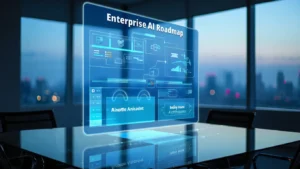Improving the Last-Mile Delivery Experience with AI in Logistics
In the logistics market, the last-mile delivery segment has continually presented major hurdles to organizations. This important stage of the delivery process, which transports items from a transportation hub to their final destination, is well-known for its complexity and high cost. By 2024, last-mile delivery will account for 53% of overall shipping costs, stressing the need for optimization.
The introduction of Artificial Intelligence (AI) has emerged as a game changer in tackling these issues. AI’s capacity to process large volumes of data in real-time and make intelligent judgments is transforming last-mile deliveries. From route optimization to predictive analytics and self-driving trucks, AI is not only increasing efficiency but also dramatically lowering operational expenses. As we further explore the role of AI in altering last-mile delivery, it becomes clear that this technology is not simply an option, but a must-have for organizations seeking to compete in the competitive logistics market of 2024 and beyond.
The Impact of AI on Last-Mile Delivery
The integration of Artificial Intelligence (AI) into last-mile delivery has ushered in a new era of efficiency and innovation. Beyond the conventional benefits of route optimization and predictive analytics, AI is extending its influence into various aspects of the delivery process, reshaping the logistics landscape. Using advanced algorithms and machine learning, companies are now able to tackle some of the most persistent challenges in last-mile delivery with unprecedented precision. The following points illustrate the multifaceted impact of AI in this critical sector:
-
Dynamic Scheduling and Capacity Planning:
AI systems can predict fluctuations in delivery volumes and help allocate resources more effectively. This includes optimizing delivery personnel schedules and vehicle use to match anticipated demand. AI algorithms can adjust delivery schedules in real time based on changing conditions such as traffic, weather, or last-minute customer requests, ensuring that deliveries remain efficient and timely.
-
Address Validation and Correction:
AI tools can automatically validate and correct addresses during the order process, reducing the risk of failed deliveries due to address errors. AI algorithms are trained to recognize patterns in address data, enabling them to validate addresses by comparing input data against a comprehensive database of valid addresses. Over time, AI models learn from corrections and successful deliveries, improving their ability to predict and correct address errors automatically.
-
Load Optimization:
AI algorithms can optimize how packages are loaded into delivery vehicles, ensuring that space is used efficiently and the order of deliveries minimizes the need for rearrangement. This decreases the overall fuel consumption and emissions associated with delivery operations.
-
Sustainability Initiatives:
AI can help companies reduce their carbon footprint by optimizing routes and delivery operations, contributing to more sustainable delivery practices. For instance, AI algorithms ensure that each delivery vehicle is loaded to its optimal capacity, reducing the number of trips required to deliver the same amount of goods.
-
Enhanced Security:
AI technologies can strengthen the security of last-mile deliveries by monitoring for potential threats and anomalies in real time. This can include detecting suspicious activities around delivery vehicles or identifying potential security breaches in the delivery process.
By incorporating these additional AI-driven solutions, companies can further improve the efficiency, reliability, and sustainability of their last-mile delivery operations.
How AI Improves Last-Mile Delivery in Logistics
The integration of Artificial Intelligence (AI) into last-mile delivery in logistics has brought about significant improvements in various aspects of the delivery process. Here’s how AI is making a difference:
Dynamic Routing:
AI dynamically adjusts delivery routes based on real-time data, reducing travel times and fuel consumption. This leads to cost savings and faster delivery times for customers. By analyzing factors like traffic and weather conditions, AI optimizes routes to ensure efficient and timely deliveries. This improves the overall efficiency of last-mile delivery, benefiting both logistics companies and customers.
Demand Forecasting:
AI accurately predicts future demand, helping logistics companies optimize inventory levels and delivery schedules. This reduces the risk of stockouts and overstocking, improving customer satisfaction and cost-effectiveness. By analyzing historical data and market trends, AI provides valuable insights that enable better resource planning and decision-making. This ensures that logistics companies can meet customer demand efficiently and effectively.
Delivery Scheduling:
AI optimizes delivery schedules by considering factors like delivery windows and traffic patterns. This improves operational efficiency and reduces delivery times. By analyzing real-time data, AI can adjust schedules to ensure deliveries are made on time. This results in customer satisfaction and reduces the risk of delays. Overall, AI improves the accuracy and efficiency of delivery scheduling, benefiting both logistics companies and customers.
Real-time Tracking:
AI-powered tracking systems provide real-time updates on delivery status and location. This improves transparency and customer satisfaction by keeping customers informed about their deliveries. By analyzing data from GPS trackers and other sources, AI ensures that deliveries are made on time and in the most efficient manner. This boosts the overall customer experience and improves the efficiency of last-mile delivery.
Fraud Detection:
AI helps detect and prevent fraudulent activities in the delivery process. By analyzing data from delivery routes, signatures, and customer behavior patterns, AI can identify suspicious activities and alert logistics companies to potential fraud. This improves the security of the delivery process and reduces the risk of fraud-related losses. Overall, AI increases the reliability and trustworthiness of last-mile delivery, benefiting both logistics companies and customers.
Optimized Inventory Management:
AI optimizes inventory levels by accurately predicting demand. This helps logistics companies maintain optimal inventory levels, reduce storage costs, and improve order fulfillment rates. By analyzing data from sales trends and other sources, AI provides valuable insights that enable better inventory management. This ensures that logistics companies can meet customer demand efficiently and effectively, improving customer satisfaction and cost-effectiveness.
Customer Behavior Analysis:
AI analyzes customer behavior and preferences to offer personalized delivery options. This improves the overall customer experience and increases customer loyalty. By understanding customer preferences, AI helps logistics companies tailor their delivery services to meet individual needs. This affects customer satisfaction and increases the likelihood of repeat business. Overall, AI enhances customer experience and strengthens the relationship between logistics companies and their customers.
Environmental Impact Reduction:
AI reduces the environmental impact of last-mile delivery by optimizing delivery routes and promoting the use of eco-friendly vehicles. By optimizing routes, AI minimizes travel distances and reduces fuel consumption and emissions. This helps logistics companies reduce their carbon footprint and support sustainability efforts. By promoting the use of eco-friendly vehicles, AI helps reduce air pollution and improve environmental quality. Overall, AI helps logistics companies operate in a more sustainable and environmentally friendly manner, benefiting both the environment and society.
Challenges and Considerations
While the integration of AI into last-mile delivery offers numerous benefits, it also presents several challenges and considerations that must be addressed:
Regulatory and Safety Concerns:
Using autonomous delivery vehicles and drones raises questions about safety and regulatory compliance. DHL Freight Connections highlights the licensing issues and risk of accidents that still hamper the widespread introduction of AI delivery bots and drones on the last mile. Navigating these regulatory hurdles and ensuring the safe operation of autonomous delivery systems is important for their successful deployment.
The Need for Accurate and High-Quality Data:
AI algorithms rely heavily on data to make informed decisions. DHL emphasizes the importance of accurate, relevant, timely, and high-quality data for the success of AI in last-mile delivery. Inaccurate or incomplete data can lead to suboptimal routing, delivery delays, and other operational inefficiencies.
Balancing Automation with Human Oversight and Intervention:
While AI can automate many aspects of last-mile delivery, it is essential to maintain a balance between automation and human intervention. Human oversight is necessary to manage exceptions, handle complex situations, and ensure quality control. Striking the right balance between AI-driven automation and human judgment in the delivery process is essential for optimizing the efficiency and effectiveness of last-mile logistics.
These challenges underscore the complexity of integrating AI into last-mile delivery operations. Addressing these concerns requires a collaborative effort between technology providers, logistics companies, regulatory bodies, and other stakeholders to develop robust solutions that harness the full potential of AI while ensuring safety, compliance, and operational excellence.
Future Trends and Developments
The future of last-mile delivery is set to be shaped by several key trends and developments, driven by the advancements in AI technologies:
Increased Automation with Regulatory Frameworks:
As AI technologies continue to evolve, there is an expectation that governments around the world will develop regulatory frameworks to facilitate the safe and efficient use of autonomous vehicles, drones, and other AI-powered delivery systems. Shipa predicts that once these frameworks are in place, last-mile delivery will undergo a transformative shift, with increased automation leading to faster, more cost-effective, and more reliable delivery services.
Enhanced Personalization and Sustainability:
AI-powered route optimization and vehicle allocation are expected to bring about significant improvements in personalization and sustainability. Shipa and Wise Systems both highlight how AI algorithms can tailor delivery options to individual customer preferences, such as preferred delivery times and locations, thereby improving the customer experience. Additionally, by optimizing routes and ensuring that delivery vehicles are loaded to their optimal capacity, AI can help reduce fuel consumption and emissions, contributing to more sustainable delivery practices.
Integration of AI in Adaptable and Flexible Delivery Networks:
The future will likely see AI integration in creating delivery networks that are both adaptable and flexible. This will involve leveraging AI to dynamically allocate deliveries to a combination of human drivers and autonomous vehicles or drones, optimizing efficiency and reducing costs. As AI algorithms become more sophisticated, they will enable companies to respond more effectively to changing conditions and customer demands, ensuring that the delivery network remains resilient and responsive to market needs.
The future of last-mile delivery is poised for significant advancements, with AI playing a central role in driving automation, personalization, sustainability, and adaptability in delivery networks. As technology continues to evolve and regulatory frameworks are established, we can expect to see a more efficient, customer-centric, and environmentally friendly last-mile delivery landscape.
Final thoughts
The integration of Artificial Intelligence (AI) into last-mile logistics has changed the industry, offering unparalleled efficiency, cost savings, and customer satisfaction. AI’s ability to optimize routes, predict demand, and tighten security has transformed how logistics companies approach the final stage of delivery. By dynamically adjusting routes, AI reduces travel times and fuel consumption, leading to significant cost savings. Additionally, AI’s predictive analytics enable better resource planning, ensuring that companies have the right inventory levels and staff to meet customer demand.
Real-time tracking and fraud detection further improve transparency and security, boosting the overall delivery experience. As AI continues to evolve, its impact on last-mile delivery will only grow, making it an indispensable tool for logistics companies seeking to stay competitive in the ever-changing market.
Contact RTS Labs today to learn how our cutting-edge solutions can optimize your last-mile delivery, reduce costs, and increase customer satisfaction.







